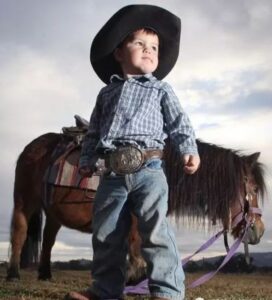What defines denim?
Denim is a firm durable yarn-dyed warp twill cotton fabric. The warp yarns are dark in color, usually indigo blue, and the weft yarns are light in color, usually light gray or scoured white yarn. Also known as indigo labor cloth.
Denim originated in the American West and was named after the cattle ranchers who used it to make clothes. The warp yarn adopts size dyeing combined with one-step dyeing process. The special numbers are 80tex (7-inch count), 58tex (10-inch count), 36tex (16-inch count), etc. The special numbers of weft yarn are 96tex (6-inch count), 58tex (10-inch count). count), 48tex (12 inch count), etc., using 3/1 weave, and also using twill, plain weave or crepe weave denim. The gray fabric has been treated with anti-shrinkage finishing, the shrinkage rate is smaller than that of ordinary fabrics, the texture is tight, thick, and the color is bright. The lines are clear. Suitable for men’s and women’s jeans, denim tops, denim vests, denim skirts, etc.
【Denim-Background】
Denim (French: Denim), also transliterated as denim, is a thick cotton twill fabric specially used to make jeans. Denim originally only came in blue and was originally used as canvas. However, it now comes in many different colors and can be used to match different clothing.
The English name Denim comes from Nîmes (Nîmes) in France, so the cloth produced locally is called de Nim, which means “from Nîmes”.
Later entered the United States
The warp yarn adopts size dyeing combined with one-step dyeing process. The special numbers are 80tex (7-inch count), 58tex (10-inch count), 36tex (16-inch count), etc. The special numbers of weft yarn are 96tex (6-inch count), 58tex (10-inch count). count), 48tex (12 inch count), etc., using 3/1 weave, and also using twill, plain weave or crepe weave denim. The gray fabric has been treated with anti-shrinkage finishing, the shrinkage rate is smaller than that of ordinary fabrics, the texture is tight, thick, and the color is bright. The lines are clear. Suitable for men’s and women’s jeans, denim tops, denim vests, denim skirts, etc.
In the 1980s, U.S. denim production accounted for 50% of global production. However, in the past decade, China, India, Pakistan, Malaysia, Turkey and Mexico have established a large number of denim production plants, and the United States and even The world’s center of denim production has shifted to low-labor-cost countries in Asia. In 2000, China’s denim output was approximately 2,424t, and its imported indigo dye was 759t. In 2001, its output had risen to 2,717t, and its imported indigo dye had dropped to 702t.
In the denim market, while cotton is undoubtedly the most important, a range of blends are also used, such as cotton/polyester (50/50) blends, as well as cotton with other fibers such as Tencel, linen, and even jute, Wool yarns are woven together.
These denim products are different from many products on the denim market, which give consumers a high level of product design and high value-added clothing. The use of mercerized stretch denim and ring-spun yarns can also increase the value of products, and some companies have invested in these areas. Ring-spun yarns offer higher strength properties, a softer feel and a slub yarn look on the surface of cotton denim.
Global denim production exceeds 2 billion meters, with open-end or ring-spun yarns. In the past, the United States mainly produced weft stretch denim, while Europe mostly produced warp stretch or two-way stretch denim. People continue to develop denim with fashionable changes, and obtain novel appearance, feel and performance through dyeing and finishing.
Heavy denim had been used as a fabric for trousers and jackets, but in the 1990s consumers demanded softness, comfort and easy care, so denim finishers had to to respond to these requests.
Research continues to alter the appearance of denim through various chemical treatments, as well as using effects such as flocking, embroidery and coatings. In addition, the products developed include indigo-dyed denim jacquard fabrics, cotton hemp denim or knitted fabrics, as well as laser rays on denim, dim gloss patterns, and more personalized products.
Two items recommended from WingFly:
15oz neppy selvedge denim fabric:
15oz Selvedge Neppy Denim Material Affordable Selvage Jeans Cloth Manufacturers WF373
17oz hemp selvage denim fabric:
17 oz Custom Selvedge Hemp Denim Fabric Hairy Selvage Jeans Cloth Material Low Moq OEM WHC178515
【Denim-History】
More than five hundred years ago, the Italian navigator Columbus discovered the New World. The sails used by sailing ships at that time were made of a rough cloth that was very tough and practical. This rough fabric was originally produced in NIMES, a small town in France, so it was named “Serge De Nimes” in French, and was later referred to as DENIM.

Three hundred and sixty years later, Levi Strauss, a Jewish businessman in the United States, introduced a rough canvas to the United States, thereby creating a historic page in jeans and establishing a mythical kingdom of denim culture.
The mythical kingdom of Levi’s jeans began in San Francisco, USA. The rough canvas originally used to make tents was used to create the first pair of LeviS jeans for the miners at that time. It was a tough and durable work clothes that was very suitable for the needs of workers. It quickly became popular, triggering a chain of evolutions. The jeans were originally brown, but later changed to dark blue twill fabric (Denim).
Denim is mainly made of cotton, and has also developed using a variety of raw material structures, including blends of cotton, wool, silk, and hemp natural fibers, blends with chemical fibers, and elastic yarns, tightly twisted yarns, fancy yarns, etc. as raw materials. The higher the spandex content, the greater the elasticity. The yarn count has various specifications such as 7*7, 7*6, 7*8, 10*7, etc. The tissue structure is generally twill (2/1, 3/1, 1/3), broken twill, and the radial tightness is greater than Latitude.
Denim is mainly made of cotton, and has also developed using a variety of raw material structures, including blends of cotton, wool, silk, and hemp natural fibers, blends with chemical fibers, and elastic yarns, tightly twisted yarns, fancy yarns, etc. as raw materials. The higher the spandex content, the greater the elasticity. The yarn count has various specifications such as 7*7, 7*6, 7*8, 10*7, etc. The denim structure is generally twill (2/1, 3/1, 1/3), broken twill, and the warp tightness is greater than Latitude.
The color of denim has developed from vulcanization and indigo to light blue, black, white, colorful, etc.
【Denim-Finishment】
Refers to the finishing process of denim gray fabric, including singeing, desizing, mercerization and preshrinking. The finishment is beneficial to removing floating colors and improving the color fastness to rubbing. Different finishing processes will have different results.
Singeing
Process flow
Cloth feeding → brushing device → singeing → flat washing tank → material trough → cloth dropping device
Singeing is mainly to remove the hairiness on the surface of the gray fabric, so that the appearance of the finished product can be smooth and smooth with clear texture. However, during the entire singeing process, we often encounter many problems that we need to solve and improve.
Desizing
Process flow
Feeding cloth → washing tank (temperature 95℃) → padding and desizing enzyme (temperature 90℃) → steaming → hot water washing (4 times) → cold water washing (2 times) → drying → cloth dropping
Vehicle speed: 35m/min
Desizing enzyme JN-260 6g/L
Nacl 3 g/L
The desizing machine has two feed troughs at the front of the machine and a water washing tank with a temperature of 95°C.
The main function is to wash out the slurry that has been expanded by the high-temperature padding penetrant, so that the desizing enzyme can be completed by reducing the original 10 g/L desizing enzyme to 6 g/L, thereby saving the use of desizing enzyme. use, reducing costs.
Mercerized
Process flow
Feeding cloth → padding with caustic soda → straight roller area → cloth clip opening → pickling → hot water washing → cold water washing → drying → cloth dropping
During the mercerization process, the weft yarn is often stained due to the color fastness of the dye. How can we better control the weft staining problem? After trying, the concentration of caustic soda can be adjusted according to the thickness of different fabrics. Thin fabrics can reduce the concentration of caustic soda and add a certain amount of mercerizing penetrant. Relatively thick fabrics can appropriately increase the concentration of caustic soda. Caustic soda has a weak reducing effect on sulfur dyes, so when mercerizing varieties with dry sulfur black or indigo and sulfur dyes, we can appropriately reduce the concentration of caustic soda and increase the tension to prevent partial shedding of sulfur dyes and cause weft yarns Staining.
Preshrunk
Process flow
Feeding fabric → skewing → drying → rubber blanket pre-shrinking → blanket shaping → fabric dropping
The purpose of denim pre-shrinking is to pre-shrink the fabric to a certain amount in the warp and weft directions, thereby reducing the shrinkage of the final product and meeting the quality requirements of garment processing.


